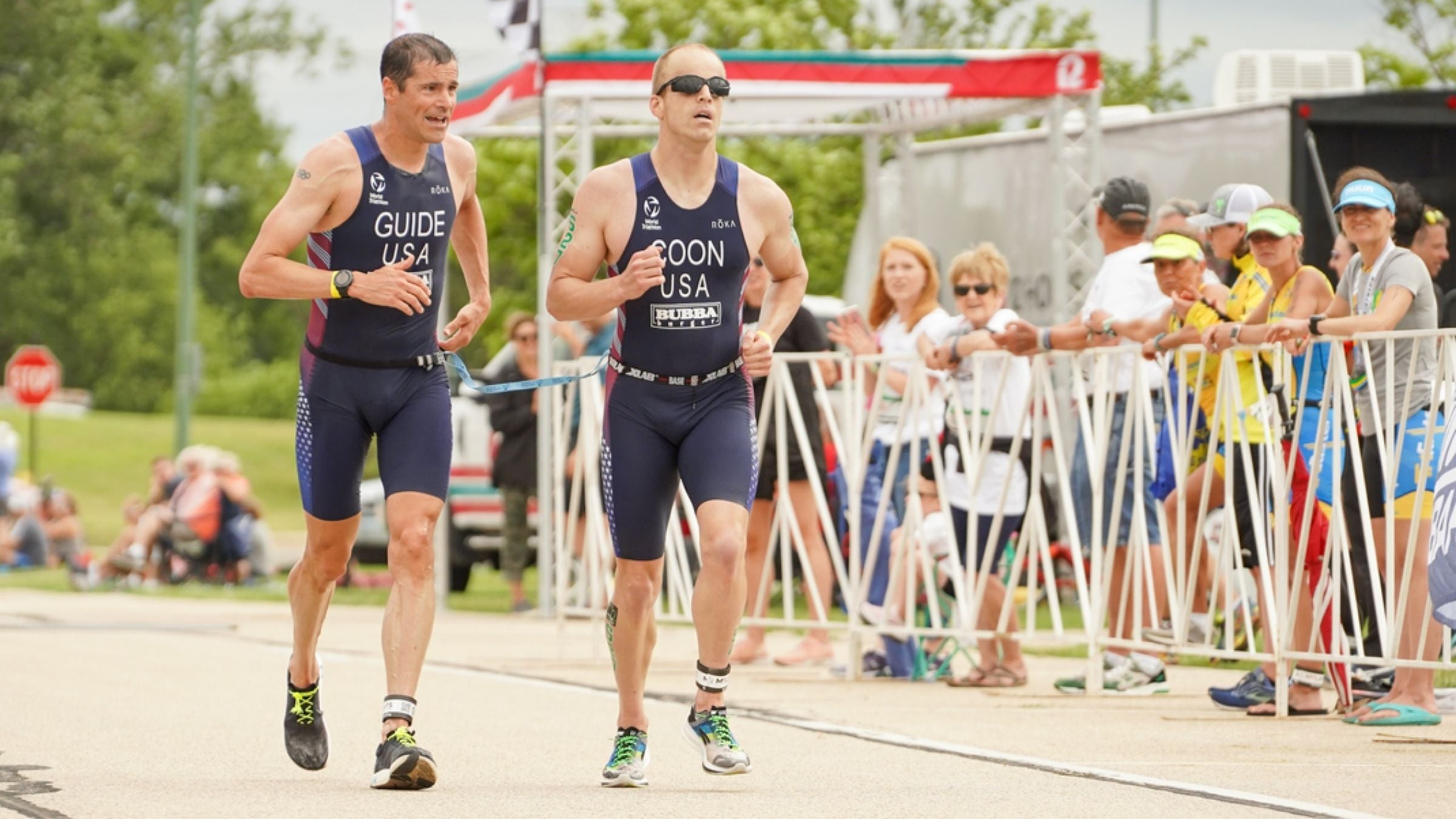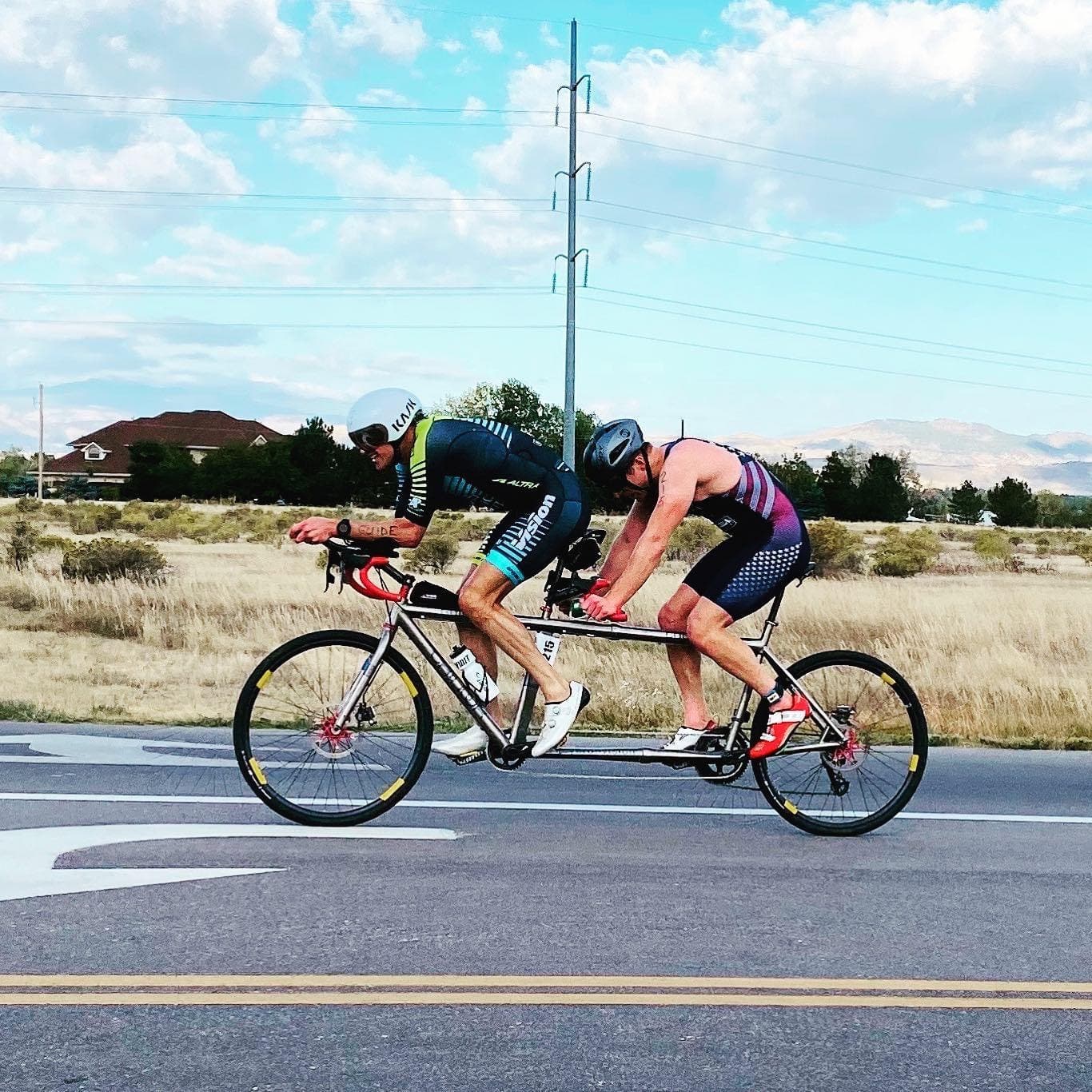Olympian Andy Potts Finds New Spark as Guide for First-Time Paralympian Kyle Coon

(Photo: Focal Flame Photography)
On Friday, Aug. 27 at 5:30 p.m. ET, blind triathlete Kyle Coon will make his Paralympic games debut in the visually-impaired (PTVI) division. The guide by his side? The highly-decorated pro and Ironman champ Andy Potts, who, at 44, remains one of the fastest long-course athletes in the game. The experience has bonded them as good friends—and offered Potts unexpected bonus time on the world’s stage in the twilight of his pro career. Here’s more about their unique relationship on and off the race course.
In 2019, blind elite triathlete Kyle Coon had just moved to Colorado Springs, Coloado, and was looking for someone to guide him around nearby cycling routes. A friend suggested he reach out to local resident Andy Potts, who, as a longtime pro triathlete, knew a thing or two about where to ride in the area.
“I thought about contacting him, but figured that he had better things to do than guide me,” recalled Coon, 29, who lost his sight to cancer when he was six years old and had to have both of his eyes removed. “I mean it’s Andy Potts. I’d been following his career for years, since I got into the sport. He was a legendary figure in my mind.”
Coon didn’t contact Potts—at first. But about a year later, during the COVID-19 lockdown, he found himself in the predicament of needing a guide for an upcoming triathlon, just a month away. The catch? The guide had to live locally, to comply with the COVID rules at the Olympic Training Center, where Coon resides, drastically narrowing his options. And, truth is, considering Coon boasts a sub-11-hour Ironman PR, there just aren’t that many cyclists who could match his athletic strength—and who would be willing to take on the demands of tandem swimming and running as well.
RELATED: How to Watch Paralympics Triathlon
So Coon shot Potts a direct message. Hey you probably don’t remember this, he wrote. But you once said you’d be open to guiding. Would you be interested?
Meanwhile, Potts, 44, was in the unfamiliar position of having a less-than-full plate, at least when it came to triathlon. With the pandemic disrupting the 2020 race schedule, as well as his coaching business and training camps, the father of two had been hunkered down with his family, and his schedule was flexible for the first time in decades. “I didn’t have something big to look forward to at the moment,” Potts said. “This gave that something.”
Potts received the DM from Coon, and responded in three words: Let’s do it.
Being a guide for a visually impaired triathlete is an arduous undertaking that, aside from the obvious physical demands, requires a meticulous attention to detail, a personality that will mesh with the athlete, and a heaping dose of mutual trust. In the swim, the guide and the athlete are connected by a tether secured at each of their thighs; the guide taking on the responsibility of keeping the pair swimming straight and avoiding entanglements with buoys and other swimmers. The guide then “pilots” a tandem bike, sitting up front to steer, brake, and communicate data like speed and power. And on the run, the guide and athlete run tethered waist-to-waist, with the guide giving directional cues and moral support as needed.
The learning curve can be steep, even for a seasoned pro. On their first bike ride together, Coon and Potts hit it off, chatting like old buddies. (“We’re just two dudes who love triathlon and who like to work hard,” said Coon.) But there were some wobbly moments, too—not surprising, considering they push twice as many watts as Potts would individually, and can churn out speeds of close to 30 mph on a flat road.
“The speed can be overwhelming,” said Potts. “And the turning radius on the tandem bike is not exactly sharp. Fortunately, Kyle is very still and holds his position really well and has amazing proprioception which helps us stay upright, so we picked up a rhythm quite quickly.”

After just a couple of weeks of training last fall, Coon and Potts toed the line of their first race, the Last Call Triathlon in Loveland, Colorado, which covered the standard sprint distance competed in the Paralympics. Coon, the only physically-challenged athlete in the field, finished 11th out of 188 participants. The results emboldened the pair’s confidence, and they began targeting Tokyo for 2021. The following April, Coon went on to win the men’s visually impaired category at the Sarasota-Bradenton Triathlon in April, beating his long-time rival, Aaron Scheidies, for the very first time. Two months later, he finished second behind Brad Snyder, who is also guided by a former Olympian in Greg Billington, at the Paralympic Trials in late June, locking up his spot on Team USA.
RELATED: U.S. Paralympic Triathlon Team Announced for Tokyo
While Tokyo has been on Coon’s radar for years, it was an unexpected bonus for Potts. After all, Potts, a 2004 Olympian, had long moved on from shorter distance racing, and for the past several years has kept his focus laser-trained on Kona, where he has finished as high as fourth. Potts actually continued to train for Ironman through last spring while regularly meeting up with Kyle, finishing 8th at Ironman Tulsa just a month before the Paralympic trials. (And until the World Championships were postponed to February, Potts was slated to race there just five weeks after the Paralympics.) Still, he scaled back much of the rest of his individual race plans to support Coon’s efforts.
“It’s been easy to make this a priority,” he said of his partnership with Coon. “I want Kyle to realize his dreams. I’m invested in giving him the best.”
Aside from being his guide, Potts has evolved into a mentor of Coons’, offering tips on being a professional in the sport, often peppering their training sessions with anecdotes plucked from his two decades in the sport. “Andy will just tell me stories from all of his different races,” said Coon. “And I draw from his experiences to fight through bad days and motivate me.”
For his part, Coon has taught Potts technical tricks, like putting together and taking apart a tandem bike. And Coon has forced Potts to be a better communicator, just by virtue of having to keep up constant chatter as they train. “That’s actually enhanced my relationship with my wife,” Potts said.
Getting to race on the world’s stage at the Paralympics as a 44-year-old, 18 years after being named USA Triathlon Rookie of the Year, is a privilege that’s not lost on Potts. Having races scrubbed from the schedule during the pandemic shifted his perspective, and made him reevaluate his role in triathlon. This experience with Coon, he hopes, will be a way to extend his legacy beyond just the personal accomplishments and podiums.
“After having races taken away last year, you realize what’s truly important. For me, I’m adamant about leaving the sport better than I found it, and Kyle is huge in that regard,” said Potts. “I’ve had a lot of great experiences, and a wonderful career. But helping Kyle to achieve this dream is making it so much better.”
RELATED: What is Paratriathlon? Understanding Triathlon in the Paralympics